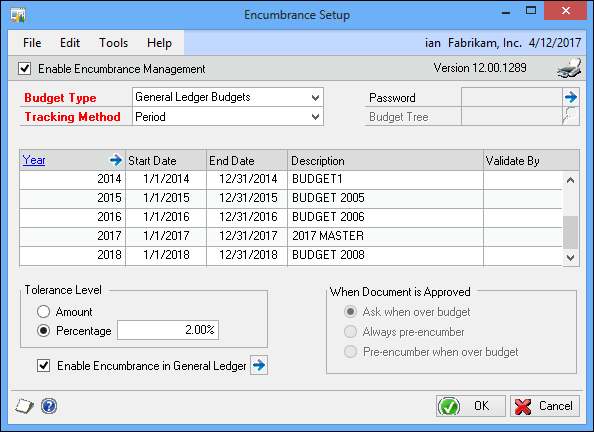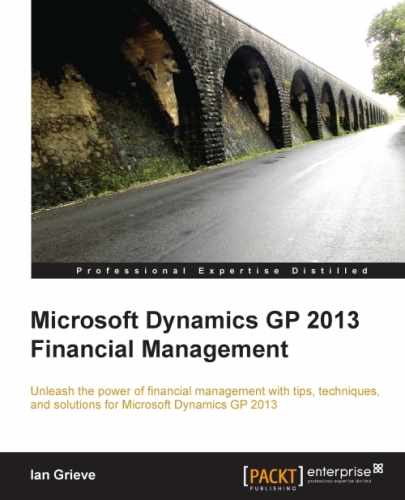Encumbrance Management enables funds to be reserved from a budget when a purchase order is created. The creation of encumbrances reduces the risk of overspending and ensures that funds will be available when payments become due. This module is often used by non-profit organizations as a part of their budget and fund accounting.
Encumbrances and PO Commitments are very similar in form and function, but there are differences in how Dynamics GP handles them. The basic differences are:
- Encumbrance Management tracks history in Dynamics GP, whereas PO Commitments does not
- Encumbrance Management requires each open year to have a budget selected for encumbering transactions, whereas PO Commitments allow individual years to have a budget defined against them
- Encumbrance Management does not integrate with Business Portal Requisition Management, but PO Commitments does
In this chapter we will take a look at the setup of Encumbrance Management, entering purchase orders, and then reporting and enquiring on the encumbrances.
When Encumbrance Management is being configured, it is recommended that all other users log out of Dynamics GP.
To set up Encumbrance Management, perform the following steps:
- Open the Encumbrance Setup window in Dynamics GP by selecting Purchasing from the Navigation Pane on the left, and then clicking on Encumbrance Management in the area page under Setup.
- Mark the Enable Encumbrance Management checkbox.
- Leave Budget Type set to General Ledger Budgets. Encumbrance Management also allows encumbrances against Analytical Accounting and Grant Management budgets, but in this book we will focus on using the standard General Ledger budgets that we looked at in Chapter 3, Budget Creation and Maintenance.
- Set the Tracking Method to Period so that the purchase order line amounts are compared to the budget and actual amounts for the period. The other options available for Tracking Method are:
- Fiscal Year, where the purchase line amount is compared to the total budget and actual for the fiscal year. This tracking method is not the one I would recommend, as it would allow a transaction in the first fiscal period to use the entire year's budget.
- Budget-to-Date is one, along with Period, which I tend to recommend. This method allows any unused period's budget amount to be used in the current period.
- Total Budget allows for tracking amounts against a budget, which does not align with a fiscal year. This method is also recommended for use when blanket purchase orders are being used.

- Click on the expansion button (blue arrow) in the Year scrolling window to open the Encumbrance Budget Setup window.

- In the Year drop-down selector, enter or do a lookup, and select the relevant budget (the Description can be changed if desired).
As of Dynamics GP 2013, Encumbrance Management allows multiple budgets to be selected for each fiscal year; to select more than one budget, enter each one on a different line in the scrolling window; this is useful when departments are using separate budgets.
- When all years have been assigned to use at least one budget, click on the OK button to close the Encumbrance Budget Setup window.
- Under Tolerance Level, click on Percentage and enter
2.00%to allow a variance between the actual and budget amounts for the period.The following table describes how positive and negative amounts work with each tolerance type level:
If you enter a positive value
If you enter a negative value
Amount
Purchases can exceed the budget amount by the currency amount you specify
Purchases must be under the budget amount by the currency amount you specify
Percentage
Purchases can exceed the budget amount by the percentage you specify
Purchases must be under the budget amount by the percentage you specify
Source: Microsoft Dynamics GP Not for Profit Accounting manual © Microsoft Corporation
- By default, when setting up Encumbrance Management, Enable Encumbrance in General Ledger will be checked; uncheck it if journals are to be allowed on the GL without affecting encumbrances.
- Clicking on the expansion button will open the Encumbrance Account Selection window, where codes can be removed from affecting encumbrances when a journal is entered.
- To retain control over transactions that exceed budget limits, an authorization password can be entered by clicking on the expansion button next to the Password field in the upper-right corner of the window.
- Click on the expansion button and enter
ACCESSin both the New Password and Reenter New Password fields. - Click on OK to close the Encumbrance Password Setup window.
- Click on OK to accept the setup and close the Encumbrance Setup window.
With Encumbrance Management set up for use, we can move on to entering transactions.
